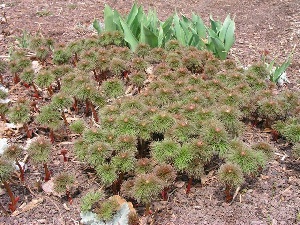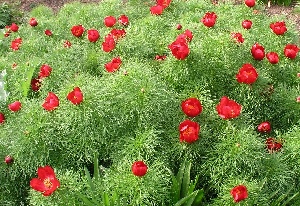 |
 |
|
|
|
||
Preliminary
Study on Paeonia tenuifolia, its Variants and Hybrids
compiled for
SPIN (Species Peonies International Network) December 1993 by Irmtraud
Rieck, Germany
shortened
version for Heartland Peony Society, with kind permission of the author
1.0 Morphology
 |
 |
|
|
|
||
| In Gottlob's, my husband, and my recent studies on seeds we are presently of the opinion that the seeds of P. tenuifolia and related forms ('Rosea', hybrida, lithophila ) have a unique shape and can be distinguished from all the other species. The seed form is oblong oval, length up to 8 mm and breadth up to 4 mm, the seed coat smooth, glossy and the colour dark brown. This is nothing special, but the characteristic part of the seed is the hilum. Compared to the size of a seed it is fairly long (2-3 mm) and lined, not punctuated. The hilum is protuberant, emerging about 1 mm above the small side of the seed. This year we noticed some seeds having a suture around the seed length, giving the impression of two halves stuck together and looking as if they had come out of a casting mould. |
|
P. tenuifolia subsp.biebersteiniana (Ruprecht) Takhtadzjan (1966) (15/2 Cooper p. 23,24)
P. carthalinica Ketzechoveli 1959 (15/4 Cooper p.24/25)
P. x Majko Ketzechoveli 1959 (15/5 Cooper p. 25)
P. hybrida Pallas (24/133)
|
P. tenuifolia
'Alba'
|
|
Bibliography
